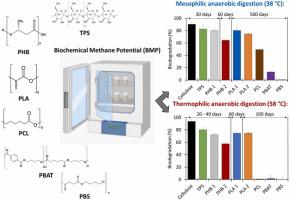Journal of Hazardous Materials ( IF 12.2 ) Pub Date : 2022-10-20 , DOI: 10.1016/j.jhazmat.2022.130208 G Cazaudehore 1 , F Monlau 2 , C Gassie 3 , A Lallement 2 , R Guyoneaud 3

|
Biodegradable plastics, if they are not properly managed at their end-of-life, can have the same hazardous environmental consequences as conventional plastics. This study investigates the treatment of the main biodegradable plastics under mesophilic and thermophilic anaerobic digestion using biochemical methane potential test and the microorganisms involved in the process using amplicon sequencing of the 16 S rRNA. Here we showed that, only PHB and TPS undergone important and rapid biodegradation under mesophilic condition (38 °C). By contrast, PCL and PLA exhibited very low biodegradation rate as 500 days were required to reach the ultimate methane yield. Little or no degradation occurred for PBAT and PBS at 38 °C. Under thermophilic conditions (58 °C), TPS, PHB, and PLA reached high levels of biodegradation in a relatively short period (< 100 d). While PBS, PBAT, and PCL could not be converted into methane at 58 °C. PHB degraders (Enterobacter and Cupriavidus) and lactate-utilizing bacteria (Moorella and Tepidimicrobium) appeared to play an important role in the PHB and PLA degradation, respectively. This work not only provides crucial data on the anaerobic digestion of the main biodegradable plastics but also enriches the understanding of the microorganisms involved in this process, which are of great importance for future development of the treatment of biodegradable plastics in anaerobic digestion systems.
中文翻译:

通过嗜温和嗜热厌氧消化生物降解塑料生物降解过程中的活跃微生物群落
可生物降解塑料如果在使用寿命结束时没有得到妥善管理,可能会产生与传统塑料相同的有害环境后果。本研究利用生化甲烷潜能试验研究了主要可生物降解塑料在常温和嗜热厌氧消化下的处理情况,并利用 16 S rRNA 的扩增子测序研究了该过程中涉及的微生物。在这里,我们表明,只有 PHB 和 TPS 在嗜温条件(38 °C)下经历了重要且快速的生物降解。相比之下,PCL 和 PLA 的生物降解率非常低,因为需要 500 天才能达到最终的甲烷产量。PBAT 和 PBS 在 38 °C 时很少或没有发生降解。在高温条件下 (58 °C),TPS、PHB 和 PLA 在相对较短的时间内达到高水平的生物降解 (< 100 天)。而 PBS、PBAT 和 PCL 在 58 °C 下无法转化为甲烷。PHB降解剂(肠杆菌和Cupriavidus)和乳酸利用菌(Moorella和Tepidimicrobium)似乎分别在 PHB 和 PLA 降解中发挥重要作用。这项工作不仅为主要生物降解塑料的厌氧消化提供了重要数据,而且丰富了对参与该过程的微生物的理解,这对于厌氧消化系统中生物降解塑料处理的未来发展具有重要意义。


















































 京公网安备 11010802027423号
京公网安备 11010802027423号